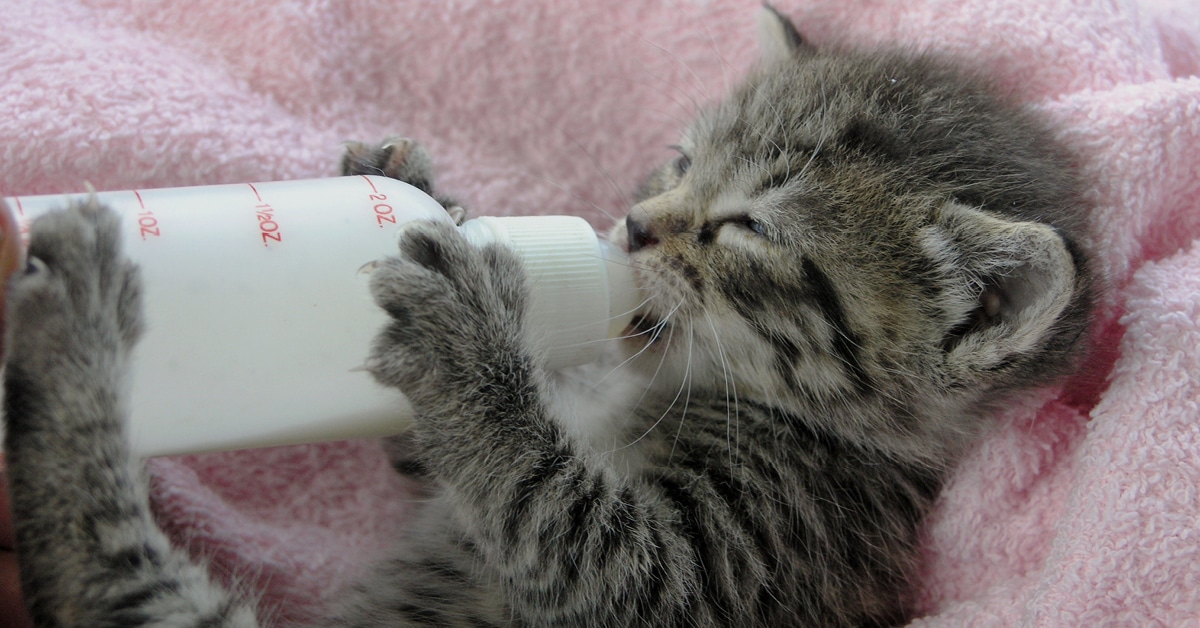When a kitten is without a mother, it’s up to us to lend a hand. Keeping kittens warm, bottle feeding, assisting with grooming, and stimulating urination and defecation are all essential skills for any kitten rescuer. Learn the basics with this step-by-step tutorial.
Keep the kitten warm
Since they cannot regulate and control their own body temperature very well, we must help maintain the kitten’s body warmth for them. Use a warm rice sock or heating pad on low setting, with a blanket or towel between the kitten and the heat source. Kittens should also have access to an area away from the heat source so they can move away if they get too warm.
Get a bottle/syringe and nipple*
Be aware that the nipple that comes on the bottle may not have a hole cut into it. (*Miracle Nipples are often well liked by kittens and can easily be attached to either a syringe or bottle.)
Assess the kitten
Before you feed a kitten, always make sure you’ve assessed her to make sure it is safe to feed. If a kitten is overheated or too cold, it is not safe to feed until they have gently stabilized their temperature. Ensure that the kitten is able to swallow by placing a drop of formula on her tongue and feeling the throat with one finger. If the kitten appears stable, proceed.
Prepare the kitten formula
Until kittens are about 3 weeks old, they will need to be bottle fed kitten formula. This formula is specially formulated to provide complete nutrition to kittens. Kittens should not be fed cow’s milk or other dairy products as these can be dangerous or even fatal to the kitten. Prepare the formula according to the label instructions, making sure that it is fresh, clump free, and comfortably warm.
Feed the kitten
Lay the kitten in a natural, bell-down position—never, ever on her back. Hold the kitten’s head stable with your non-dominant hand. Gently slide the nipple into the kitten’s mouth and invert the bottle to start the flow of formula. The kitten should roll her tongue into a U-shape and begin to swallow. Follow the feeding chart for a guideline of amount and frequency.
**Most kittens can start eating a mixture of formula and canned food at 3-4 weeks old.
Be careful not to squeeze formula into the kitten’s mouth as this can cause aspiration. If you are feeding a very young kitten and having a difficult time controlling the flow, consider syringe feeding. If the kitten latches, that’s great, but it’s okay if it takes a while for her to get the hang of things! Bottle feeding is an art form that improves with time, so be patient and don’t give up. If this kitten is having difficulty, try these things;
- Be sure you’re holding the head and body stable to guide her. Kittens don’t necessarily understand what you’re trying to do, so it’s up to you to hold them steady and show them.
- Take a look at your bottle and nipple, and make sure there are no issues such as a nipple that is cut too big or too small, or clumps in the formula that may be causing a blockage.
- Wrap the kitten in a small baby blanket if needed to help her feel focused and swaddled; just make sure she is still in a proper belly-down position.
- Rubbing the face with a cloth or toothbrush can simulate a mother’s tongue and help a kitten feel prepared to eat.
Clean up afterwards
After feeding, always ensure that you’re cleaning the face by wiping away any formula with a warm, wet cloth or baby wipe. Formula left behind can cause the kitten to get a crusty face or moist dermatitis that causes fur to fall out, so keep her clean.
Stimulate urination and defecation
Kittens under 3 weeks of age are unable to urinate and defecate without being stimulated to do so. If their mother is not available to help with this process, you will be responsible for helping them out. With a damp cotton ball or paper towel, gently rub the kitten along the urogenital area until she urinates and/or defecates. A kitten should urinate before and/or after every feeding, and should defecate at least once daily if stimulated properly.
